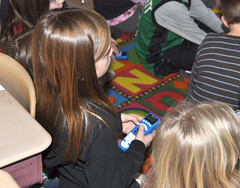Imagine the “Ask the Audience” option on the syndicated TV show “Who Wants to be a Millionaire” and you’ll have a good understanding of a new clicker technology brought to Portland, CT, second-graders by a Neag graduate school alumna.

Amy Raines is the one responsible for bringing the idea to Valley View Elementary. While working full time, Raines completed her master’s degree in educational technology at UConn’s Neag School last summer. During that work, she discovered the clickers in use by older students and thought about how to apply them to her second-graders.
She then wrote a grant application to the local Gildersleeve Wheeler Education Fund, and last school year won $12,000 to equip Valley View’s second-grade with the devices. Now all schools in the district have the clickers. Even the kindergartners use them.
“Yes, it’s exactly like ‘Millionaire,’” says Jenna Ferrara, Raines’ colleague and an early user of the clickers at Valley View. Ferrara has a 2006 bachelor’s and 2007 master’s degree in education from the Neag School.
The clickers include a small display screen, A-through-E multiple-choice answer keys and a numerical keypad. Students can retrieve their scores immediately and, without knowing which answers they missed, be allowed to go back in and try again, Raines says.
While the clickers work best for concrete subjects such as math, teachers use them for writing, too. Raines says a writing prompt essay, with the student’s name removed, will be displayed on the Smart Board. The class can grade the sample using the clickers and then discuss how to improve it. For the teachers, the technology means instantaneous data, time saved by computer grading of tests, less chance of cheating because of the tiny screens, and opportunity to tailor follow-up teaching to individuals rather than require the whole class to sit through tedious discussions of every wrong answer. For students, it means instant feedback, a video game kind of allure and an end to the drudgery of drilling for, say, the Connecticut Mastery Tests.
“It’s just excitement,” says Ferrara. “You take something boring, and they’d go ‘ugh.’ But with this, they go, ‘Oh, OK. I get to use a clicker. No problem.’”
Neag School Associate Dean Marijke Kehrhahn is encouraged to hear about the clicker technology.
“Both Jenna and Amy are great role models for what we stress in our programs,” says Kehrhahn. “They exhibited initiative and leadership skills in bringing technology into their school and integrating it into their teaching with the ultimate goal of improving student learning.”
 Facebook
Facebook
 Twitter
Twitter
 LinkedIn
LinkedIn
